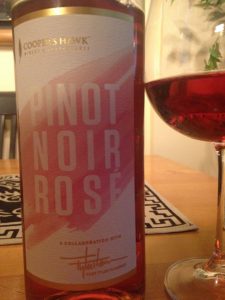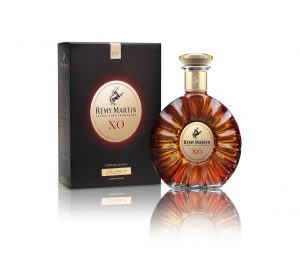Monthly Archives: June 2017
Lovely white – William Fèvre Chablis Champs Royaux 2015

Chablis. Remember how that was practically the only white wine we knew of back in the 70s? I always liked Chablis; didn’t know or care at the time that it was made with Chardonnay grapes – and still is today. So it came as a surprise to me that I didn’t like the original heavily oaked Chardonnay wines that came from those same grapes. Happily these days, the oaking craze has settled down quite a bit.
To my further surprise, years ago when I was searching out a white burgundy, a favorite of mine, I finally realized many of those bottles were labeled Chablis – and learned that the Chardonnay grapes used to make them are grown in Burgundy. For a good discussion of this slightly confusing situation, read Eric Asimov of the New York Times on Chablis.
William Fèvre is known for producing exceptional Chablis wines that are excellent expressions of the ideal growing conditions in their Grands Crus terroirs. In this Champs Royaux 2015 you’ll taste the minerality of the sea and the chalky soils typical of the area – which makes it a perfect pairing with oysters. Winemakers notes: Fresh bouquet of citrus and white fruits, very slight oak finish, fresh and supple,
Some experts claim Chablis is the only wine that pairs perfectly with oysters. I’m not going to argue with that or the recommendation of consuming oysters, grilled fish or sushi with this one. But I also think it has enough structure to stand up to roast pork with a light sauce or even a creamy beef Stroganoff. It’s a white wine with backbone, like some white burgundies I’ve had. At $25 a bottle, you can be proud to present this as a host/ess gift or just as a treat for yourself.
Greek wines make a splash in Chicago

Remember retsina from the 60s and 70s? It was the only name most Americans associated with Greek wines back then – and it wasn’t usually a pleasant link. But this year, the Wines of Greece brought a collection of winemakers and wines to City WInery in Chicago’s West Loop that dramatically changed a lot of people’s opinions about Greek winemaking.
In the red category, a favorite new Greek grape is Agiorgitiko (ah-jor-git-ee-ko). Be sure to pronounce it correctly – as one of the reps explained to someone who asked, if Americans can learn to pronounce Gewurtztraminer, they can learn to pronounce Greek grape names! This grape, too, makes some lovely wines on its own or in blends with indigenous Greek grapes like Kydonitsa, Moschofilero and Xinomavro.

We were more than pleasantly surprised at the quality of the wines at this event. It was a unique educational opportunity to experience the viniculure of a country that has not previously been known for fine wines. Since my daughter lived in Greece for almost a year while on her world tour back in the late 90s, it’s an extra special pleasure to see how far the country has come in creating delicious wines. You’ll need to consult with your wine vendor or Binny’s to see about getting particular wines through the importers. Here are a few that stood out at the tasting:
Tsantali Rapsani Reserve Red 2012. ***** This vineyard is in northern Greece, near Italian vineyards that grow Barolo. Grapes: Xinomavro, Krassato, Stavroto. Imported by Fantis Imports, Inc.
Domaine Costa Lazaridi Amethystos White 2016. ***** Grapes: Sauvignon Blanc, Assyrtiko. Serve this 5-star lovely with seafood or grilled fish. Imported by Nestor Imports, Inc.
Argyros Estate Atlantis White 2016. ***** Grapes: Assyrtiko, Ahtiri, Aidani. This blend contains 90% Assyrtiko yet takes on just the right subtleties with the small addition of 5% of each of the other grapes. Imported by Athenee Importers.
Wine Art Estate Idisma Drios Assyrtiko 2016. ***** Grapes: Assyrtiko only. Compare this to a dry Riesling and enjoy the same ways.
Lantides Winery Nemea Lantides 2012. ***** Grapes: Agiorgitiko only. This wine can be aged up to 10 years. It’s excellent for an aperitif. The winery grows 60-70% of its own grapes and buys the rest from trusted sources. Imported by Dionysos Imports.
Greek Wine Cellars GWC Santorini 2016. ***** Grapes: Assyrtiko only. Grown from really earthy old vines. Volcanic soils and the nightly sea mist mineralize this wine. Imported by Fotis & Son Imports.
Domaine Hatzimichalis Estate Hatzimichalis Lefkos White 2016. **** Grapes: Sauvignon Blanc, Malagousia, Robota. This vineyard is located one hour north of Athens. Serve this white with grilled chicken, fresh salads or pork. Imported by Fantis Imports.
Bairaktaris Winery Old Monolithos Red 2012. **** Grapes: Agiorgitiko only. This wine is the epitome of old-world winemaking and the commitment to making wines that taste of their place. Pair with pork, steak, burger, or aged yellow cheese.
Food news you can use
- Just Spices is a German company that makes a series of flavorful seasoning powders, some spicy, some sweeter (like the new berry flavoring for yogurt) that are USDA organic and “sourced with love.”
The one for barbecue popcorn is a surprise – it gives your evening popcorn a barbecue flavor that doesn’t hit you like a ton of bricks, like many BBQ seasonings do. Especially if you pop your popcorn in coconut oil – so delicious – you don’t want to overwhelm it with spice. This BBQ seasoning is delicate yet definite enough to make your mouth pay attention.
Just Spices Mexican makes a salad special Just Spiaces – BBQ popcorn and Mexican flavors Serving idea – Mexican-spiced turkey meatballs with zucchini noodles The Just Spices Mexican seasoning is transformative. Now an avocado-studded taco salad – minus the beans and the meat – can be pretty delicious with just romaine, cilantro, red onion and salsa, topped with thickened 2% Greek yogurt (lower fat and calories than sour cream) and lots of fresh lime juice. Add a few drops of Habanero sauce and you’re good to go. But then, if you add a quarter teaspoon of the Just Spices Mexican seasoning, that same dish puts you on the sun-soaked hacienda of an elegant Mexican resort. And you immediately want to order a margarita with your salad. Even if it’s 8:30 AM. We also added it to our turkey meatballs and to the tomatoes we cooked ’em in and really enjoyed the whole thing.
Go try some of these. They just introduced 20 new flavors, too. You won’t go wrong buying one of their boxed sets as a gift for a hostess or friend who enjoys cooking but isn’t fanatical about making their own seasoning. These provide a shortcut that any non-professional cook – and maybe some professionals, too – will appreciate. Each individual package is 100 milliliters and priced from $5.99 to $7.99. Available online only at www.justspices.com/ -

Peter & Pat’s Pierogies make an easy dinner entree Peter & Pat Pierogies. And how about some low-fat, low-cholesteraol all-natural pierogies to back up – or be – your dinner entree? Peter & Pat love traditional Eastern European food so much they built it into a thriving catering business over the past 20 years. The most popular dish on their menu is the pierogies. In fact, theirs has become one of the top-selling pierogie brands in the United States. It’s been so successful they’ve now officially launched in Costco locations across the Midwest.
We can personally vouch for the flavor and filling ability of the 4-cheese-and-potato version they sent to test – delicious mix of creamy mashed potatoes with Cheddar, farmers, Parmesan and Swiss cheeses. Yet only 240 calories for four pierogies – not bad for so much creamy, cheesy goodness. Frozen bags of 4 pounds – that’s a lotta pierogies (65 per bag – 12 servings) – for $9.99 at Costco. -

molly&drew Mug Cake mixes and beer mixes are fun and easy molly&drew® Single Serve Mug Cake Kits come in four flavors include, Ooey Gooey Chocolate, Chocolate Sea Salt Caramel, Chocolate Raspberry Cheesecake, and Chocolate Candy Cane. Just add water, microwave for 90 seconds and ditch the need to mess up the kitchen. Fast, easy dessert for one or two. Top with whipped cream to make it more decadent.
molly&drew® also craft their own beer breads and beer cakes that let you blend your favorite beer into ready-to-go mixes. Try the beer bread for appetizers, main dishes, sides and desserts. There’s a cake mix, too, which we sampled – fun to make a cake with beer. We did, however, find the sizable dose of almond extract in the Amore Amoretto flavor somewhat overpowering. We left the cakes sit out for a day and the almond flavor diminished a bit. Still, what a fun – and EASY – idea for sharing with family and friends for brunches, barbeques, dinners, parties, sporting events and more.
The Symington family of fine port wines

Interestingly, port wines often do not state vintage years. Instead, when a wine is particularly good one year, it is “declared” a vintage after it’s been bottled. Because differences in weather are unpredictable every year, only great years can command a declaration. It is always an exercise in self-restraint for port winemakers to decide which years deserve to be declared.

Some of the biggest names in port from the Douro Valley are all owned by the Symington Family Estates. Cousins Rupert and Charles Symington came to Chicago recently to introduce their exciting 2015 vintages and showcase a few of their older premium offerings.

Our favorite among all was the Cockburn’s 2015 Vintage Port, its bicentenary vintage. The Symingtons purchased Cockburn’s from the company that had been operating it since the family sold it in the 1950s – to the detriment, they believed, of the fine brand. “We wanted to bring back the spirit of Cockburn’s,” said Rupert. So they organized a tasting of some of the very oldest Cockburn’s vintages – from 1912, 1920 and so on. They knew, then, what their goal would be to engineer the re-birth of the Cockburn excellence. Their 2015 has lush aromas and flavors of maraschino and black cherry that eventually turn into Kirsch-like flavors. Rupert described it as “tropical jungle.” The 2011 vintage port is a perfect example of this super-refined structure and power of the Cockburn port profile: dark, brooding, powerful.
Cooper’s Hawk Winery intros new rosé wine

Cooper’s Hawk Winery and Restaurants runs a wine club that takes a unique approach to the concept. It invites wine club members to parties several times a year to introduce the company’s newly released wines and refresh members’ appreciation of other available wines. One such recent party, held in the lovely outdoor-and-indoor event space at Ignite Glass Studios, 401 N. Armour St., and entitled “An Evening with Tyler Florence and Cooper’s Hawk,” got members together for a gourmet dinner and to introduce a new rosé wine from Cooper’s Hawk.
Profile – Rémy Martin Cellar Master Loiseau

The message is clear: Rémy Martin XO Cognac, savored slowly, yields oh-such-rich rewards. Baptiste Loiseau is young to be in charge of creating some of the finest Cognacs in the world. At 36 – tall, slender, handsome and impeccably groomed – he is the youngest Cellar Master ever to be appointed to the Rémy Martin house of fine Cognacs. And he’s earned that place, learning at the right hand of Rémy Martin’s then-Cellar-Master after having already paid his dues studying wine making around the world.

But his heart was drawn back to Cognac. Having experienced the rich multitude of aromas emanating from those small copper pot stills full of eau de vie, he wanted to learn what was going on in there. So his next step was to spend two years researching the connections between grapes and eau de vie. And that’s when Rémy Martin invited him to join their team, led by their Cellar Master – actually, Mistress. She took him under her wing and taught him everything she knew about how to turn eau de vie into the distinct style of Rémy Martin. He spent seven years under her expert tutelage, learning how to select the eau de vie, determine the quality of the cask, and make the blends. “She was like my mother at work,” said Baptiste.

Okay, what’s the right way to taste the finest Rémy XO? You must take your time, says Baptiste. The aromas reveal themselves gradually as the liquid sits in the glass. First, you will notice some fruitiness. Then comes the richer flavors of nuts. And later, the surprise of complements to dark chocolate. “Do you keep the chocolate in your mouth when you taste the Cognac?” He nodded and watched my surprise as I experienced an explosion of flavors and sensations all around my mouth – utterly delightful. He smiled. “That is what happens when you combine dark chocolate with XO. But you have to wait a while. The right complementary flavors and aromas are not released until the liquid has been in the glass for a little while.”
“The floral notes don’t reveal themselves until the spirit has aged at least 10 years,” he said. “The bitterness of the chocolate highlights the softness of the spirit.” He kept murmuring: “butterscotch, oranges, rich, yeasty brioche…” It was a pleasure to see how deeply involved he was in experiencing and naming all the complexities of this magnificent Cognac. Gives the rest of us something to aspire to.
Besides the XO, Rémy Martin makes a VSOP that exhibits a harmony of flavors like vanilla and dried apricots. 1738 expresses nuts and vanilla. If you’re looking for a luxury gift for your Cognac-loving dad or grad, you won’t go wrong with Remy Martin.












